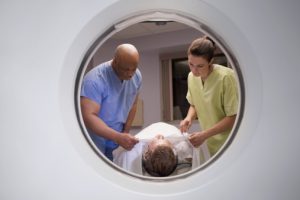 When a man presents with high levels of prostate-specific antigen (PSA), doctors often follow up with biopsies to detect any signs of cancer. This is an invasive procedure and it can be very stressful.
When a man presents with high levels of prostate-specific antigen (PSA), doctors often follow up with biopsies to detect any signs of cancer. This is an invasive procedure and it can be very stressful.
Researchers have found that adding two MRI variables may improve diagnosis and reduce the risk of unnecessary biopsies.
Advertisement
Senior study author Baris Turkbey explained, “It has become more common that the results of multiparametric MRI are used to guide clinical decision-making on prostate biopsy.”
The study included 651 participants and consisted of a developmental and validation cohort. The men showed at least one sign of prostate cancer and had at least one lesion detected with a subsequent MRI. Post-MRI, the men’s “index” lesion was given a PI-RADSv2 category. Men with a category of three or higher underwent an MRI-transrectal ultrasonography fusion-guided biopsy and a 12-inch core systematic biopsy.
The 400 men in the developmental cohort had no previous sign of prostate cancer.
Of the developmental cohort, 193 men had clinically significant prostate cancer and from the validation cohort, 96 of the 251 men developed clinically significant prostate cancer.
The study revealed that the MRI [risk-prediction] model which used the standard measures along with two MRI-derived elements outperformed the basic model of diagnosis. The MRI model had lower false-positives compared to the baseline model.
The authors explained, “In clinical practice, the threshold for biopsy should be decided after a physician and patient both weigh the relative harm of potentially unnecessary biopsy and benefit of diagnosing clinically significant prostate cancer. Therefore, there is not a single risk threshold that is used to determine who needs to undergo biopsy but rather a range of risk thresholds.”
The researchers suggest that among the validation cohort, 38 percent of biopsies could have been avoided using the MRI model and 89 percent of clinically significant prostate cancers would have still been diagnosed.
The authors wrote, “The net reduction in the number of false-positives based on the MRI model, compared with having to perform a biopsy in all patients with positive MRI results, was equivalent to performing 18 fewer unnecessary biopsies per 100 men, with no increase in the number of clinically significant prostate cancer left undiagnosed.”
Additional studies need to be carried out before the MRI model of prostate cancer diagnosis can be fully rolled out, but so far it shows promise in being an effective diagnostic measure to reduce unnecessary biopsies.
Advertisement
Related:
More precise prostate-specific antigen test on the horizon
Avoid these 4 foods for a healthier prostate
